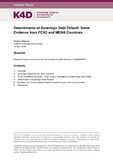Determinants of Sovereign Debt Default: Some Evidence from FCAS and MENA Countries
Abstract
Debt vulnerabilities have amplified in recent years in many developing countries – including many fragile and conflict-affected states (FCAS) and those in the Middle East and North Africa (MENA) region. Debt defaults in FCAS, MENA or other group of developing countries can be the consequence of either bad financial and macroeconomic policymaking at home, and/or because of external shocks such as a sudden rise in global interest rates, crises in financial centre countries (e.g. US and Eurozone), commodity price volatility, or natural disasters. There is a large body of literature on debt defaults. However, there are very limited number of empirical studies that explicitly highlight the issue for FCAS or MENA countries. Much of the literature on sovereign debt default and its determinants have focused on High income countries or emerging economies with well-developed capital markets. Furthermore, the limited pool of research on the topic that makes some passing mention of FCAS and MENA countries rarely studies them separately. Instead, these studies (that often utilize multi-country panel datasets) study FCAS/MENA countries together with other countries. Some multi-country studies employ dummy variables or specific control groups for countries. However, these efforts are usually limited to the separation of developing or emerging countries from advanced economies – or low-debt countries from high-debt ones. Conversely, many studies simply lump all countries together in their panel dataset). This rapid literature review is limited to some academic publications as well as reports issued by international financial and development agencies. The review of influential empirical studies (see Section 5) has identified several useful determinants or indicators for sovereign debt defaults in FCAS, MENA and other countries. Some of these indicators include: total debt to GDP ratio, debt to exports ratio, external debt as percentage of reserves, external debt as percentage of gross national income, short-term debt to reserves ratio, debt service to revenues ratio, debt service to reserves ratio, new financing needs, GDP growth, GDP per capita, trade openness, institutional quality, inflation rate, currency overvaluation, treasury bill rate, current account as percentage of reserves, primary deficit, volatility of fiscal policy, etc.
Citation
Megersa, K. (2019). Determinants of Sovereign Debt Default: Some Evidence from FCAS and MENA Countries. K4D Helpdesk Report. Brighton, UK: Institute of Development Studies.Is part of series
K4D Helpdesk Report;689Rights holder
© DFID - Crown copyright 2019Collections
- K4D [937]

